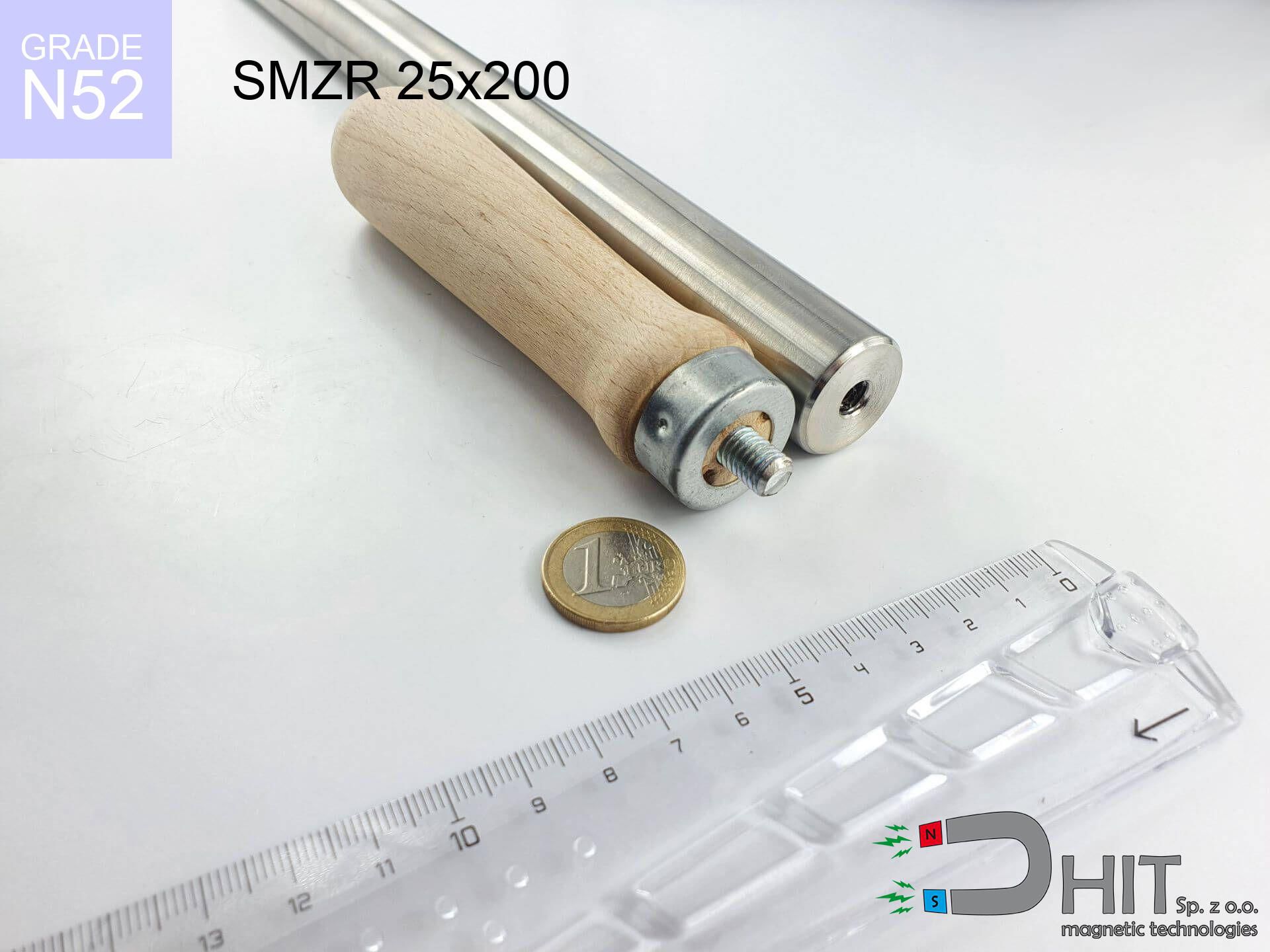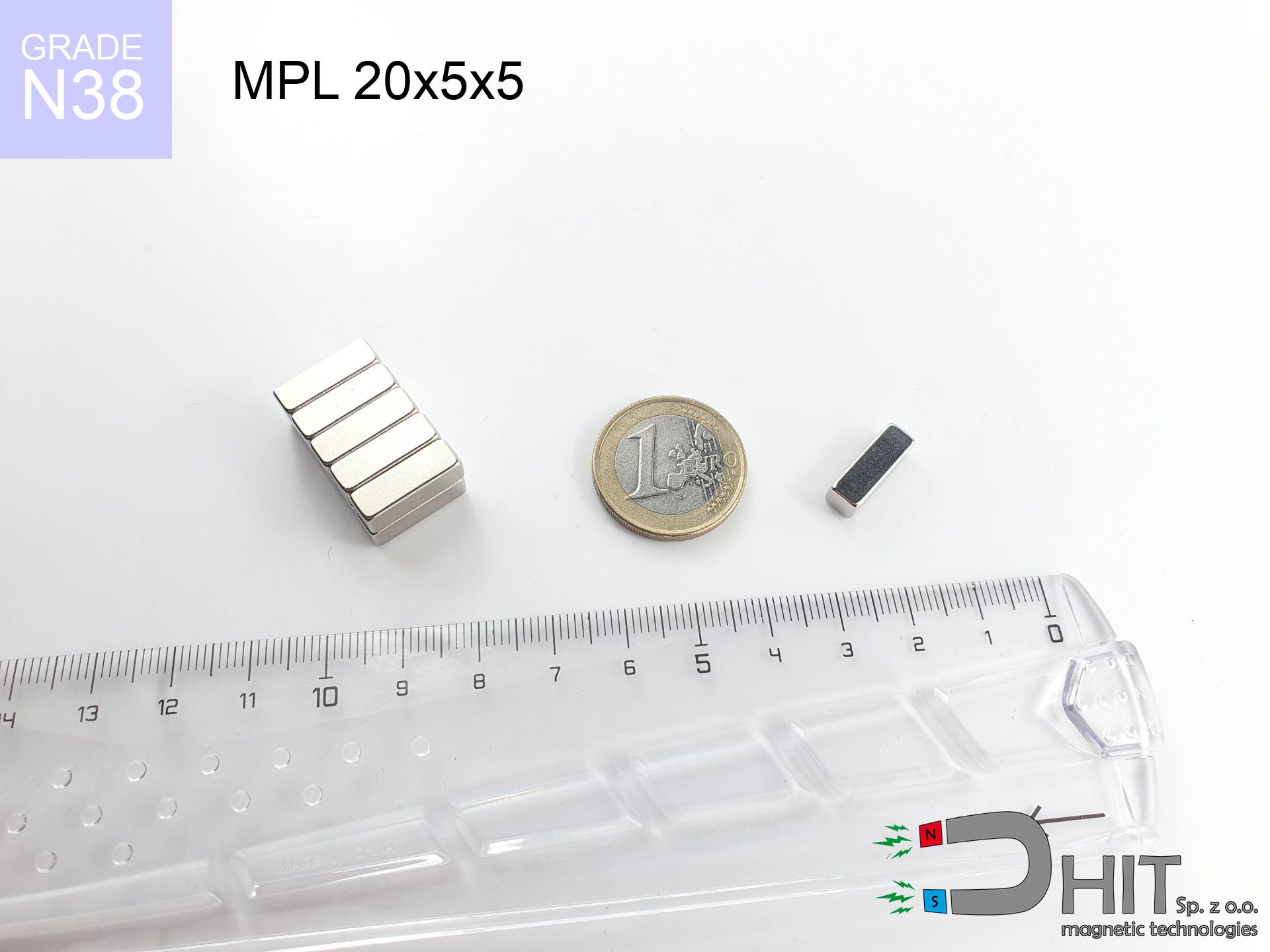SMZR 25x200 / N52 - magnetic separator with handle
magnetic separator with handle
Catalog no 140444
GTIN/EAN: 5906301813507
Diameter Ø
25 mm [±1 mm]
Height
200 mm [±1 mm]
Weight
0.01 g
Magnetic Flux
~ 9 500 Gauss [±5%]
553.50 ZŁ with VAT / pcs + price for transport
450.00 ZŁ net + 23% VAT / pcs
bulk discounts:
Need more?
Give us a call
+48 888 99 98 98
or send us a note by means of
form
our website.
Parameters and appearance of a neodymium magnet can be reviewed with our
magnetic calculator.
Order by 14:00 and we’ll ship today!
Technical - SMZR 25x200 / N52 - magnetic separator with handle
Specification / characteristics - SMZR 25x200 / N52 - magnetic separator with handle
| properties | values |
|---|---|
| Cat. no. | 140444 |
| GTIN/EAN | 5906301813507 |
| Production/Distribution | Dhit sp. z o.o. |
| Country of origin | Poland / China / Germany |
| Customs code | 85059029 |
| Diameter Ø | 25 mm [±1 mm] |
| Height | 200 mm [±1 mm] |
| Weight | 0.01 g |
| Material Type | Stainless steel AISI 304 / A2 |
| Magnetic Flux | ~ 9 500 Gauss [±5%] |
| Size/Mount Quantity | 2xM8 |
| Polarity | circumferential - 7 poles |
| Casing Tube Thickness | 1 mm |
| Manufacturing Tolerance | ±1 mm |
Magnetic properties of material N52
| properties | values | units |
|---|---|---|
| remenance Br [min. - max.] ? | 14.2-14.7 | kGs |
| remenance Br [min. - max.] ? | 1420-1470 | mT |
| coercivity bHc ? | 10.8-12.5 | kOe |
| coercivity bHc ? | 860-995 | kA/m |
| actual internal force iHc | ≥ 12 | kOe |
| actual internal force iHc | ≥ 955 | kA/m |
| energy density [min. - max.] ? | 48-53 | BH max MGOe |
| energy density [min. - max.] ? | 380-422 | BH max KJ/m |
| max. temperature ? | ≤ 80 | °C |
Physical properties of sintered neodymium magnets Nd2Fe14B at 20°C
| properties | values | units |
|---|---|---|
| Vickers hardness | ≥550 | Hv |
| Density | ≥7.4 | g/cm3 |
| Curie Temperature TC | 312 - 380 | °C |
| Curie Temperature TF | 593 - 716 | °F |
| Specific resistance | 150 | μΩ⋅cm |
| Bending strength | 250 | MPa |
| Compressive strength | 1000~1100 | MPa |
| Thermal expansion parallel (∥) to orientation (M) | (3-4) x 10-6 | °C-1 |
| Thermal expansion perpendicular (⊥) to orientation (M) | -(1-3) x 10-6 | °C-1 |
| Young's modulus | 1.7 x 104 | kg/mm² |
Table 1: Rod construction
SMZR 25x200 / N52
| Parameter | Value | Description / Unit |
|---|---|---|
| Diameter (Ø) | 25 | mm |
| Total length | 200 | mm (L) |
| Active length | 180 | mm |
| Section count | 7 | modules |
| Dead zone | 20 | mm (Blaszka 2mm + Gwint 18mm) |
| Weight (est.) | ~746 | g |
| Active area | 141 | cm² (Area) |
| Housing material | AISI 304 | 1.4301 (Inox) |
| Surface finish | Ra < 0.8 µm | Polished |
| Temp. class | 80°C | Standard (N) |
| Force loss (at max °C) | -12.8% | Reversible loss (physics) |
| Force (calculated) | 22.6 | kg (theor.) |
| Induction (surface) | ~9 500 | Gauss (Max) |
Chart 2: Field profile (7 sections)
Chart 3: Temperature performance
Material specification
| iron (Fe) | 64% – 68% |
| neodymium (Nd) | 29% – 32% |
| boron (B) | 1.1% – 1.2% |
| dysprosium (Dy) | 0.5% – 2.0% |
| coating (Ni-Cu-Ni) | < 0.05% |
Sustainability
| recyclability (EoL) | 100% |
| recycled raw materials | ~10% (pre-cons) |
| carbon footprint | low / zredukowany |
| waste code (EWC) | 16 02 16 |
View also deals
Pros and cons of Nd2Fe14B magnets.
Pros
- Their magnetic field remains stable, and after approximately 10 years it decreases only by ~1% (according to research),
- Magnets perfectly protect themselves against loss of magnetization caused by external fields,
- A magnet with a smooth gold surface has an effective appearance,
- Magnetic induction on the working layer of the magnet turns out to be impressive,
- Through (appropriate) combination of ingredients, they can achieve high thermal strength, allowing for operation at temperatures approaching 230°C and above...
- In view of the possibility of free molding and adaptation to custom requirements, magnetic components can be modeled in a variety of shapes and sizes, which expands the range of possible applications,
- Universal use in advanced technology sectors – they are used in magnetic memories, electromotive mechanisms, precision medical tools, also multitasking production systems.
- Thanks to efficiency per cm³, small magnets offer high operating force, in miniature format,
Disadvantages
- Brittleness is one of their disadvantages. Upon intense impact they can fracture. We recommend keeping them in a special holder, which not only secures them against impacts but also increases their durability
- We warn that neodymium magnets can reduce their power at high temperatures. To prevent this, we advise our specialized [AH] magnets, which work effectively even at 230°C.
- Due to the susceptibility of magnets to corrosion in a humid environment, we suggest using waterproof magnets made of rubber, plastic or other material immune to moisture, in case of application outdoors
- We recommend cover - magnetic holder, due to difficulties in creating threads inside the magnet and complex forms.
- Health risk related to microscopic parts of magnets are risky, in case of ingestion, which is particularly important in the context of child health protection. Additionally, small elements of these products can be problematic in diagnostics medical after entering the body.
- With mass production the cost of neodymium magnets can be a barrier,
Holding force characteristics
Maximum lifting capacity of the magnet – what affects it?
- using a sheet made of mild steel, acting as a circuit closing element
- whose transverse dimension equals approx. 10 mm
- characterized by smoothness
- with zero gap (without coatings)
- under vertical force vector (90-degree angle)
- at standard ambient temperature
Lifting capacity in real conditions – factors
- Clearance – existence of any layer (rust, dirt, gap) interrupts the magnetic circuit, which reduces power rapidly (even by 50% at 0.5 mm).
- Load vector – maximum parameter is reached only during pulling at a 90° angle. The resistance to sliding of the magnet along the surface is standardly many times smaller (approx. 1/5 of the lifting capacity).
- Base massiveness – insufficiently thick plate does not accept the full field, causing part of the flux to be lost into the air.
- Material type – the best choice is high-permeability steel. Stainless steels may attract less.
- Surface finish – ideal contact is possible only on polished steel. Any scratches and bumps create air cushions, weakening the magnet.
- Temperature – temperature increase causes a temporary drop of induction. Check the thermal limit for a given model.
Holding force was tested on a smooth steel plate of 20 mm thickness, when the force acted perpendicularly, whereas under parallel forces the lifting capacity is smaller. Moreover, even a slight gap between the magnet and the plate decreases the load capacity.
Safe handling of NdFeB magnets
Power loss in heat
Keep cool. NdFeB magnets are sensitive to temperature. If you require resistance above 80°C, ask us about special high-temperature series (H, SH, UH).
Powerful field
Handle with care. Neodymium magnets act from a distance and connect with massive power, often quicker than you can move away.
Crushing risk
Big blocks can break fingers instantly. Do not put your hand between two strong magnets.
Eye protection
Neodymium magnets are sintered ceramics, which means they are prone to chipping. Collision of two magnets will cause them breaking into small pieces.
ICD Warning
Individuals with a heart stimulator should keep an large gap from magnets. The magnetism can disrupt the functioning of the implant.
Do not give to children
Only for adults. Tiny parts can be swallowed, causing severe trauma. Keep away from kids and pets.
Data carriers
Equipment safety: Neodymium magnets can damage data carriers and sensitive devices (heart implants, hearing aids, timepieces).
Avoid contact if allergic
Some people experience a sensitization to Ni, which is the common plating for NdFeB magnets. Frequent touching may cause a rash. We suggest use safety gloves.
Keep away from electronics
A powerful magnetic field negatively affects the functioning of magnetometers in phones and GPS navigation. Do not bring magnets near a device to avoid breaking the sensors.
Dust explosion hazard
Dust produced during grinding of magnets is flammable. Avoid drilling into magnets unless you are an expert.



![SM 25x150 [2xM8] / N42 - magnetic separator SM 25x150 [2xM8] / N42 - magnetic separator](https://cdn3.dhit.pl/graphics/products/sm-25x150-2xm8-cim.jpg)
![UMH 36x8x46 [M6] / N38 - magnetic holder with hook UMH 36x8x46 [M6] / N38 - magnetic holder with hook](https://cdn3.dhit.pl/graphics/products/umh-36x8x46-m6-wim.jpg)



